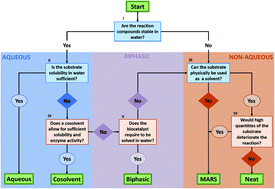Applied biocatalysis beyond just buffers – from aqueous to unconventional media. Options and guidelines†
Abstract
In nature, enzymes conventionally operate under aqueous conditions. Because of this, aqueous buffers are often the choice for reaction media when enzymes are applied in chemical synthesis. However, to meet the demands of an industrial application, due to the poor water solubility of many industrially relevant compounds, an aqueous reaction system will often not be able to provide sufficient substrate loadings. A switch to a non-aqueous solvent system can provide a solution, which is already common for lipases, but more challenging for biocatalysts from other enzyme classes. The choices in solvent types and systems, however, can be overwhelming. Furthermore, some engineering of the protein structure of biocatalyst formulation is required. In this review, a guide for those working with biocatalysts, who look for a way to increase their reaction productivity, is presented. Examples reported clearly show that bulk water is not necessarily required for biocatalytic reactions and that clever solvent systems design can support increased product concentrations thereby decreasing waste formation. Additionally, under these conditions, enzymes can also be combined in cascades with other, water-sensitive, chemical catalysts. Finally, we show that the application of non-aqueous solvents in biocatalysis can actually lead to more sustainable processes. At the hand of flowcharts, following simple questions, one can quickly find what solvent systems are viable.

- This article is part of the themed collections: Biocatalysis: A cross-journal collection, 2021 Green Chemistry Hot Articles and Green Chemistry Reviews


 Please wait while we load your content...
Please wait while we load your content...